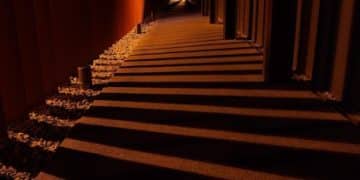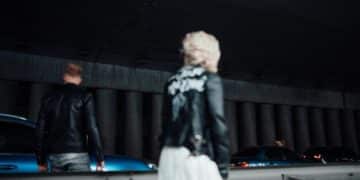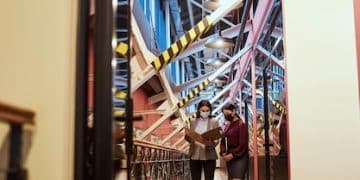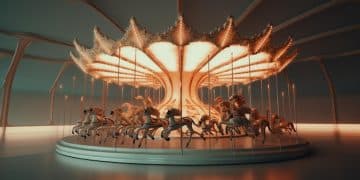Unveiling the Power of Costumes: Character Development in Theater

The Power of Costumes: How Wardrobe Enhances Character Development is a crucial element in theater, shaping audience perception and deepening narrative impact through visual storytelling.
Ever wondered how a character instantly captures your attention the moment they step onto the stage? The answer often lies in the meticulous design and thoughtful selection of their wardrobe. The Power of Costumes: How Wardrobe Enhances Character Development is undeniable, transforming actors into believable figures and breathing life into stories. This article explores just how vital costumes are to theatre.
Exploring the Power of Costumes: How Wardrobe Enhances Character Development
The Power of Costumes: How Wardrobe Enhances Character Development is a fascinating study in visual storytelling. More than mere clothing, costumes are a powerful tool used by designers to communicate a character’s personality, social status, and emotional state to the audience, enriching the entire performance.
Costumes offer crucial insights, acting as a silent language that bridges the gap between script and spectator. Understanding their subtle yet significant impact is key to appreciating the depth of character development in theater.
Costumes can speak volumes, conveying complex character nuances that go beyond dialogue. Let’s dive dipper to understand how wardrobes enhances character developmet
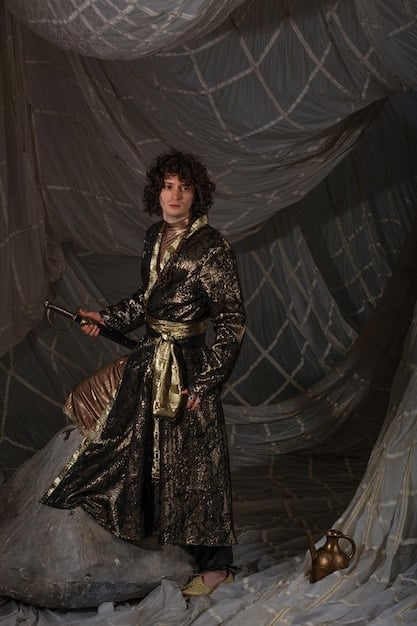
Decoding Character Through Fabric and Form
The choice of fabrics, colors, and silhouettes in a costume is never arbitrary. It’s a deliberate act of character interpretation. Each element works in harmony to visually represent traits that the actor then brings to life through performance.
The visual identity of a character is profoundly influenced by the costume they wear. It’s an integral part of the storytelling process in theater. Understanding the principles of how costumes affect character development is to understand the theater.
The Language of Color in Costume Design
Colors are incredibly powerful, each carrying its own set of associations and symbolic meanings. Costume designers skillfully leverage this to communicate aspects of a character’s personality and journey.
- Red can signify passion, anger, or danger.
- Blue often suggests calmness, sadness, or intelligence.
- Yellow might represent happiness, cowardice, or deceit.
The careful selection of a color palette for a character’s wardrobe can, therefore, significantly influence audience perception. When considering The Power of Costumes: How Wardrobe Enhances Character Development think of the use of color.
Silhouettes: Shaping the Character’s Presence
Beyond color, the silhouette of a costume helps to define a character’s physical presence and societal role. A flowing gown can denote elegance, a tightly fitted suit suggests authority, this is the power of costumes.
- Exaggerated shapes can create a sense of the grotesque or comical.
- Simple, functional designs can highlight practicality or humility.
- The overall form of a costume contributes to the character’s visual impact.
Costume choices should reflect the character’s social status, personality, and place withing the world fo the story
Examining the language of color and silhouette reveals how costumes act as crucial visual cues, guiding the audience’s understanding of character. The Power of Costumes: How Wardrobe Enhances Character Development lies in its visual impact.
Costumes as a Reflection of Time and Place
Costumes are not confined to individual expressions; they also ground the narrative in a specific time and place. Accurate representation of historical periods or cultural contexts adds authenticity to the production.
Detail to historical or cultural accuracy is important for convincing character portrayal. For the audience to believe the world of the performance, costumes must be authentic to the context.
Research and Authenticity in Costume Design
Costume designers often conduct extensive research to ensure that their creations accurately reflect the historical period or cultural context of the play. The research can involve studying paintings, photographs, and written accounts from the era to understand clothing styles, fabrics, and accessories. Considering the historical period and culture is important with costumes
Authenticity in costume design provides credibility to the production overall. This allows the audience to believe the story and enhances the performance.
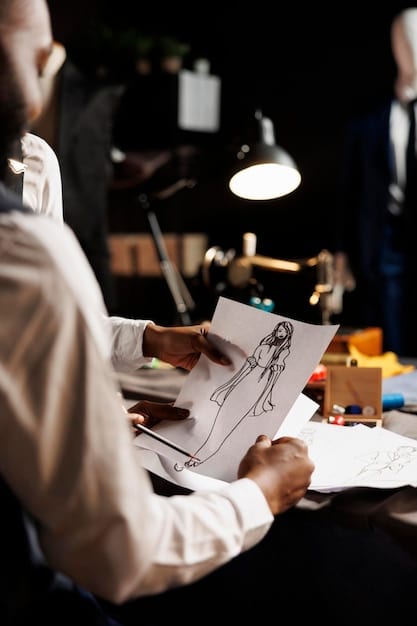
Cultural Sensitivity and Representation
When representing different cultures through costume, sensitivity and respect are essential. Designers must avoid stereotypes and caricatures, instead seeking to understand and accurately portray the traditions and values of the culture being represented. Cultural sensitivity matters.
- Collaborating with cultural consultants can provide valuable insights
- Attention to detail in fabrics, patterns, and accessories is essential.
- The overall goal should be to honor and celebrate cultural diversity
Acknowledging the cultural associations and nuances embedded within costume is essential for responsible storytelling. Paying homage to the culture or place of setting reflects The Power of Costumes: How Wardrobe Enhances Character Development.
By accurately reflecting time and place, costumes immerse the audience in the world of the play, deepening their connection to the characters and narrative. Costumes truly immerse the audience.
The Transformative Effect of Costumes on Actors
Costumes do more than just inform the audience; they also play a significant role in shaping the actor’s performance. Putting on a costume can be a transformative experience, helping the actor to fully embody their character.
In particular, The Power of Costumes: How Wardrobe Enhances Character Development directly contributes to an actor’s portrayal. Costumes act as an extension of themselves
Physicality, confidence, and presence on stage are impacted by the choice of wardrobe. Costumes shape an actor’s physicality and presence on stage
Finding the Character Through the Wardrobe
Costumes can help actors to find their character’s physicality, posture, and mannerisms. Physicality, posture, mannerisms are impacted.
- A heavy, restrictive garment might encourage an actor to move deliberately.
- A flowing, comfortable outfit might inspire a more relaxed demeanor.
- The costume can serves as a constant reminder of the character role
Actors use costumes as a tool to fully immerse themselves into the role. This also adds consistency, creating a strong relationship between the actor and the character.
Building Confidence and Stage Presence
Wearing the right costume can also boost an actor’s confidence and stage presence. When actors feel comfortable and authentic in their attire, they are more likely to fully commit to their performance.
- A well-fitting costume can enhance an actor’s physical appearance.
- A visually striking outfit can draw attention and command the stage.
- When a costume fits and looks well, it can help with confidence
Through physicality, confidence, and stage presence, costumes change the way actors act. This transformation reflects The Power of Costumes: How Wardrobe Enhances Character Development directly.
Costumes give the actor the mental image that they are the part and this is an essential part to the performance.
Collaborative Costume Creation: Designer and Actor
The most effective costume designs are often the result of a collaborative process between the designer and the actor. Sharing insights and perspectives can to lead to more authentic and compelling character portrayals.
The collaborative relationship is an open dialogue that will result in effective costume designs. The collaborative relationship produces convincing characters when considering The Power of Costumes: How Wardrobe Enhances Character Development
Sharing insights and perspectives through this process can lead to real and compelling character portrayals, enhancing the performance.
Open Communication and Feedback
Open communication is essential throughout the costume design process. The designer should actively solicit feedback from the actor on their comfort level, mobility, and overall impression of the costume. Feedback matters.
- Early conversations can help to identify potential challenges.
- Regular fittings allow for adjustments and refinements.
- The actor’s input can provide valuable insights
This iterative exchange ensures that the costume fits the actor physically and aligns with their understanding of the character by providing them with an opportunity to provide input
Experimentation and Exploration
The collaborative process can also involve experimentation and exploration. Designers and actors may try different fabrics, silhouettes, and accessories to see what best embodies the character. This experiment creates a character representation that everyone is happy with.
- Costume parts can be tested, altered, and refined to create the best product.
- Consider what matches well with the character.
- Experiment to create a cohesive and real character
Working as a team, the actor and designer both contribute to The Power of Costumes: How Wardrobe Enhances Character Development, resulting in an authentic character development. The best costumes are a result of teamwork.
Collaborative processes are important due to both designer’s and the talent’s feedback. This feedback allows for a more authentic and believable performance
Examples of Iconic Costumes in Theater History
Throughout theater history, certain costumes have become synonymous with the characters they represent, solidifying their place in popular culture. Understanding these examples shows The Power of Costumes: How Wardrobe Enhances Character Development on stage.
Analyzing these iconic outfits and understanding why they are iconic can benefit contemporary theatric production.
Iconic costumes solidify characters into popular culture due to their importance, let’s look into why.
Eliza Doolittle’s Transformation in “Pygmalion”
The costumes worn by Eliza Doolittle in “Pygmalion” (and its musical adaptation, “My Fair Lady”) beautifully illustrate her transformation from a Cockney flower girl to a refined lady. Her initial, disheveled attire contrasts sharply with the elegant gowns she wears later in the play, visually representing her social and personal evolution. Eliza’s transformation shows the character development.
- The contrast is the result of character development
- The clothes enhance the transformation
- Shows how clothes enhance character
Eliza’s image becomes synonymous with character development. Eliza Doolittle’s transformation is synonymous with the costume.
Hamlet’s Mournful Black Attire
The dark, brooding nature of Hamlet is often reflected in his costume, which typically features somber black attire. This visual cue emphasizes his grief, melancholy, and the weight of his responsibilities. Hamlet’s black attire expresses the character.
- The black signifies mourning.
- The color matches the personality.
- This adds to the iconic persona of Hamlet
Costumes add to the character as proven with Hamlet’s attire. Hamlet is seen as brooding and dark with the use of darker clothing.
Costumes can add to iconicness, this is proven in the plays with iconic outfits. Iconic outfits solidify characters in culture as proven with The Power of Costumes: How Wardrobe Enhances Character Development.
| Key Point | Brief Description |
|---|---|
| 🎨 Color Symbolism | Colors communicate a character’s emotional state. |
| 🕰️ Historical Accuracy | Authenticity grounds the narrative in time. |
| 🎭 Actor Transformation | Wardrobe helps shape the actor’s performance. |
| 🤝 Collaboration | Team work adds to authentic character portrayal. |
Frequently Asked Questions
Costumes visually communicate a character’s traits and background, aiding actors in embodying their roles and shaping audience interpretation. The Power of Costumes: How Wardrobe Enhances Character Development significantly impacts performance.
Research ensures accuracy and authenticity, grounding the narrative in a specific time and place, preventing cultural misrepresentation, and supporting the storytelling with credible visuals.
Actors provide valuable feedback on comfort, mobility, and overall impression, contributing to collaborative costume creation that aligns with their understanding of the character reinforcing The Power of Costumes: How Wardrobe Enhances Character Development.
Yes, a well-designed costume enhances an actor’s confidence and physicality, while a poorly chosen one can hinder their performance by creating discomfort or misrepresenting the character.
Color and silhouette choices communicate aspects of character’s personality, status or emotional state. This displays the importance and influence of The Power of Costumes: How Wardrobe Enhances Character Development.
Conclusion
In conclusion, costumes are an essential element in theater, acting as a powerful tool for character development and communication. They transform the actor and inform the audience.
From historical accuracy to symbolic expression, The Power of Costumes: How Wardrobe Enhances Character Development is undeniable, enriching the theatrical experience for all. It is important to appreciate the thoughtfulness costume designers put into theater arts.


